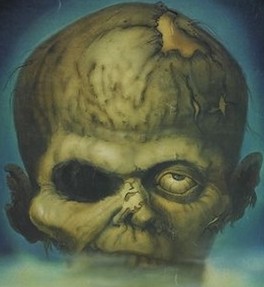 If there’s one thing horror fans can’t seem to get enough of these days it’s the living dead. Zombie-themed movies practically comprise a genre of their own, and it doesn’t appear to be losing momentum—just the opposite in fact, with AMC’S WALKING DEAD program (based on the popular comic series) posting the highest-ever ratings of any AMC show, ensuring that today’s cinematic zombie boom isn’t going to end any time soon.
If there’s one thing horror fans can’t seem to get enough of these days it’s the living dead. Zombie-themed movies practically comprise a genre of their own, and it doesn’t appear to be losing momentum—just the opposite in fact, with AMC’S WALKING DEAD program (based on the popular comic series) posting the highest-ever ratings of any AMC show, ensuring that today’s cinematic zombie boom isn’t going to end any time soon.
The living dead have also taken off in the literary sphere. In 2010, for instance, John Ajvide Lindqvist’s HANDLING THE UNDEAD and David Moody’s AUTUMN joined a landscape already overstuffed with zombie books. So popular are literary zombies that there exists at least one publishing house, Permuted Press, whose entire output consists largely of zombie fiction.
Why are zombies so popular? I’d say that’s due to several factors.
The Zombie Allure
For moviemakers the appeal of zombies is obvious enough: they’re easy. Zombies are mindless and don’t talk, thus dispensing with the need for things like dialogue, motivation or even skilled actors. Also, zombies can be cut, gouged, slashed, impaled or dismembered in just about any manner imaginable without unduly troubling viewers—zombies are by definition dead, after all, so there’s no pain involved.
For the rest of us zombies have an appealingly straightforward, blue collar vibe that other monsters lack. Zombies, as George Romero has pointed out, are “working class” fiends far removed from Dracula in his castle. They don’t hide in shadow or wait until a full moon to do their dirty work, and aren’t slowed down by guilt or romantic longings. Furthermore, there’s no dress code for zombies, and anyone can become one (unlike vampirism, a state attainable apparently only by good looking white people).
We also need to take into account the politically polarized, fearful and depressed state that currently prevails in much of the world. It doesn’t seem that far removed from the apocalyptic overtones of most zombie narratives, or the overwhelming sense of entrapment and isolation on the part of the non-zombified humans in those narratives.
The problem with today’s zombie media is simply that it isn’t especially novel or interesting. The particulars of zombie lore were established long before the advent of THE WALKING DEAD, and it doesn’t seem that modern zombiemeisters have much left to add.
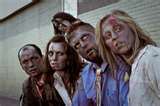 A Brief History
A Brief History
Zombies have been with us seemingly from the dawn of time, yet early incarnations differed markedly from those of current zombie film and fiction. In the old days zombies were usually the result of voodoo (as in 1943’s I WALKED WITH A ZOMBIE) or divine intervention, as was the case with Lazarus, the first-ever zombie, as well as the second, Jesus Christ.
To see how zombie lore reached its current state we need to look back to 1919, when Abel Gance’s J’ACCUSE!, the first truly modern zombie movie, hit screens. The film, a clichéd and sentimental anti-war melodrama, is of scant interest for the most part, but the finale, in which dead soldiers rise from their graves to attack the living, gave the world its first-ever Zombie Armageddon.
Abel Gance’s accomplishment was significant on several counts. The film’s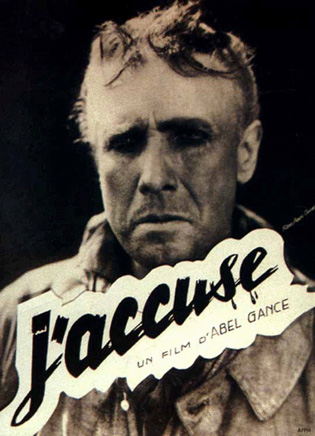 apocalyptic arc directly links with today’s zombie tales, as does its explicitly political bent (a staple of George Romero’s films and Joe Dante’s 2005 MASTERS OF HORROR segment HOMECOMING, which apes J’ACCUSE’S zombie soldier concept). A more important innovation was marked by the climactic masses of the living dead, made especially prevalent in Gance’s 1937 remake of J’ACCUSE!, which concludes with wave upon wave of the undead literally engulfing the screen. Before this zombies were lonely creatures; if you consider Mary Shelley’s FRANKENSTEIN (and its many filmic offshoots) a zombie tale, as I know many of you do, note that it contains a single ghoul harassed by the living. J’ACCUSE! reversed that situation.
apocalyptic arc directly links with today’s zombie tales, as does its explicitly political bent (a staple of George Romero’s films and Joe Dante’s 2005 MASTERS OF HORROR segment HOMECOMING, which apes J’ACCUSE’S zombie soldier concept). A more important innovation was marked by the climactic masses of the living dead, made especially prevalent in Gance’s 1937 remake of J’ACCUSE!, which concludes with wave upon wave of the undead literally engulfing the screen. Before this zombies were lonely creatures; if you consider Mary Shelley’s FRANKENSTEIN (and its many filmic offshoots) a zombie tale, as I know many of you do, note that it contains a single ghoul harassed by the living. J’ACCUSE! reversed that situation.
An equally important stage in the development of zombie mythos occurred in 1954, with the publication of the thrice-filmed I AM LEGEND by Richard Matheson. Matheson’s novel isn’t technically about zombies, but rather vampires who torment the hapless suburban protagonist, an ordinary man far outnumbered by the undead. I AM LEGEND’S vampire antagonists heavily inform modern zombie lore, which is inspired by vampires in many aspects–notably the idea that, as with vampires, a person bitten by a zombie will become one him/herself. Another similarity is the bullet in the head that permanently ends a zombie’s existence, in place of the stake to the heart capable of finishing off vampires.
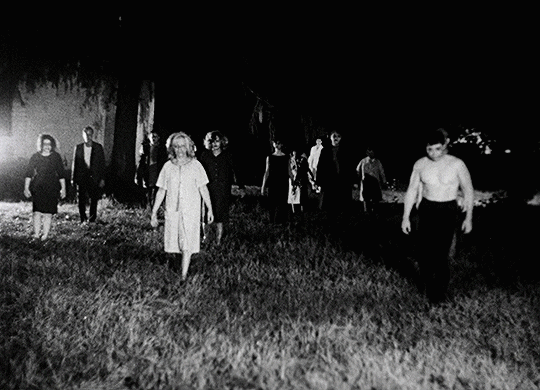 This brings us to the single most iconic zombie yarn of all time: co-writer/director George Romero’s black-and-white NIGHT OF THE LIVING DEAD, released in 1968. Heavily inspired by I AM LEGEND (as well as the climax of Herk Harvey’s 1962 CARNIVAL OF SOULS, in which the heroine was chased around by a gaggle of zombie dancers), NIGHT can be viewed as the Rosetta Stone of modern zombie lore, from its overpoweringly bleak, apocalyptic air to the claustrophobic setting (a tiny house) wherein a small band of ordinary folk are besieged by the walking dead. It also added a heretofore unutilized element: extreme (for the time) gore.
This brings us to the single most iconic zombie yarn of all time: co-writer/director George Romero’s black-and-white NIGHT OF THE LIVING DEAD, released in 1968. Heavily inspired by I AM LEGEND (as well as the climax of Herk Harvey’s 1962 CARNIVAL OF SOULS, in which the heroine was chased around by a gaggle of zombie dancers), NIGHT can be viewed as the Rosetta Stone of modern zombie lore, from its overpoweringly bleak, apocalyptic air to the claustrophobic setting (a tiny house) wherein a small band of ordinary folk are besieged by the walking dead. It also added a heretofore unutilized element: extreme (for the time) gore.
Romero’s ghouls, you see, are cannibalistic, driven by an insatiable need to eat humans, and can only be stopped by a bullet to the head. As to why the dead are rising Romero is vague, giving us some perfunctory info about radioactive contamination from an exploded space probe. The lack of any real explanation for the ghouls’ existence gives the film a powerfully nightmarish feel, which as much as anything else has carried through to NIGHT’S many, many successors.
NIGHT OF THE LIVING DEAD spawned quite a few 1970s era imitations, some good (MESSIAH OF EVIL), some not-so (CHILDREN SHOULDN’T PLAY WITH DEAD THINGS), but it took nearly a full decade for the next important step in zombie evolution to appear. That step was Romero’s 1978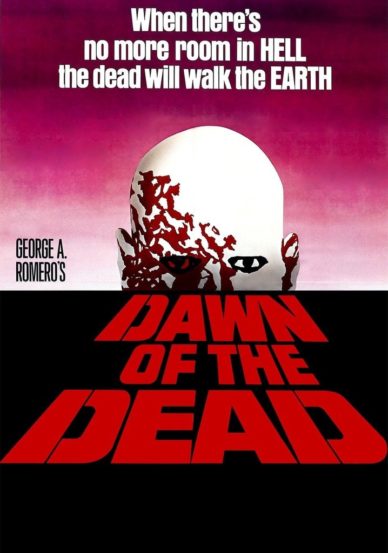 DAWN OF THE DEAD, set largely in a ghoul-packed shopping mall. DAWN contains more extreme gore than the previous film, and a powerfully naturalistic atmosphere that (still) renders it unique, as well as a distinct sense of humor. It’s this latter element more than any other that appears to have resonated—that and the fact that the zombies’ hands in DAWN are somehow able to tear through human flesh like paper, a factor that recurs in quite a few subsequent efforts.
DAWN OF THE DEAD, set largely in a ghoul-packed shopping mall. DAWN contains more extreme gore than the previous film, and a powerfully naturalistic atmosphere that (still) renders it unique, as well as a distinct sense of humor. It’s this latter element more than any other that appears to have resonated—that and the fact that the zombies’ hands in DAWN are somehow able to tear through human flesh like paper, a factor that recurs in quite a few subsequent efforts.
We can add Lucio Fulci’s Italian made ZOMBIE, a.k.a. ZOMBI 2—so named because it was intended as a sequel to DAWN OF THE DEAD, which was known as ZOMBI in Italy—to the evolutionary ladder, primarily for its rotting, maggot-ridden zombies. These creatures are a far cry from the hollow-eyed walking dead of NIGHT OF THE LIVING DEAD or the green-faced ones of DAWN, and this new graphic intensive appearance would prove quite influential. Unfortunately Fulci’s film also introduced some seriously annoying trends that have become equally influential, namely the would-be zombie victims who turn around reeeeeeeeeally slowly and then moronically stand and gawk, thus giving the slow moving zombie aggressors plenty of time to trudge up to the gawker and rip his or her throat out.
Italian filmmakers turned out quite a few zombie potboilers in the wake of Fulci’s film—see ZOMBIE HOLOCAUST, HELL OF THE LIVING DEAD, ZOMBIE APOCALYPSE and NIGHTMARE CITY (which originated the fast-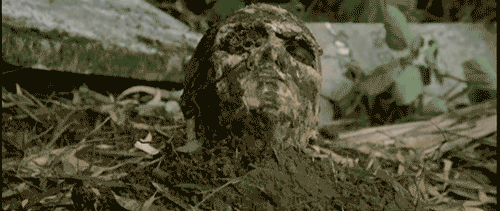 moving, weapon-toting zombie), as well as Fulci’s own CITY OF THE LIVING DEAD, THE HOUSE BY THE CEMETERY and THE BEYOND. For that matter, the Italian cannibal chomp-fests of the late seventies and eighties—CANNIBAL HOLOCAUST, SLAVE OF THE CANNIBAL GOD, EMERALD JUNGLE, etc—were a direct offshoot of the zombie wave (the Italian film industry of the seventies and eighties was much like Hollywood today, in that filmmakers had to properly answer the all-important question “What’s this like?” for their films to be greenlit).
moving, weapon-toting zombie), as well as Fulci’s own CITY OF THE LIVING DEAD, THE HOUSE BY THE CEMETERY and THE BEYOND. For that matter, the Italian cannibal chomp-fests of the late seventies and eighties—CANNIBAL HOLOCAUST, SLAVE OF THE CANNIBAL GOD, EMERALD JUNGLE, etc—were a direct offshoot of the zombie wave (the Italian film industry of the seventies and eighties was much like Hollywood today, in that filmmakers had to properly answer the all-important question “What’s this like?” for their films to be greenlit).
Back in America filmmaker Sam Raimi scored a low budget success in 1981 with THE EVIL DEAD, although 1987’s EVIL DEAD 2: DEAD BY DAWN was arguably more resonant. Its use of broad slapstick (far removed from DAWN OF THE DEAD’S humorous naturalism) was positively revelatory to audiences and filmmakers, and its jokey tone was transferred nearly verbatim to later zombie comedies like BRAINDEAD and SHAUN OF THE DEAD.
As for Romero, he put out DAY OF THE DEAD in 1985, around the same time as RETURN OF THE LIVING DEAD (a project originated by NIGHT OF THE LIVING DEAD co-scripter John Russo that somehow ended up in the hands of writer-director Dan O’Bannon). Of the two I’d say RETURN is the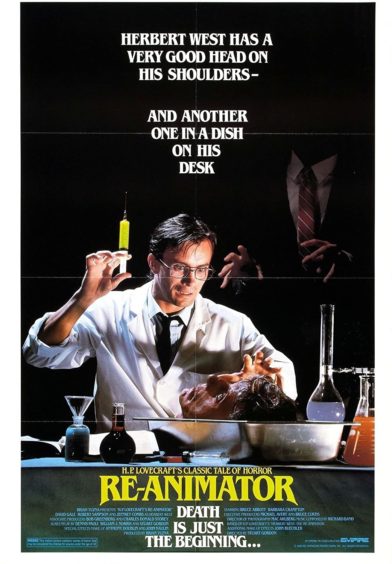 more interesting film, with a hard-driving rock ‘n roll aesthetic and overall sense of gory fun that far outdo the dour uneventfulness of DAY (which was conceived in far grander, more epic terms than the severely scaled-down bummer that resulted). Of course, 1985 also saw the release of the finest zombie film of the decade: Stuart Gordon’s RE-ANIMATOR, still one of the most hysterically outrageous and entertaining films of its type.
more interesting film, with a hard-driving rock ‘n roll aesthetic and overall sense of gory fun that far outdo the dour uneventfulness of DAY (which was conceived in far grander, more epic terms than the severely scaled-down bummer that resulted). Of course, 1985 also saw the release of the finest zombie film of the decade: Stuart Gordon’s RE-ANIMATOR, still one of the most hysterically outrageous and entertaining films of its type.
Another noteworthy film was J.R. Bookwalter’s ultra-low budget but energetic and enjoyable THE DEAD NEXT DOOR, conceived as a tribute to George Romero’s films. THE DEAD NEXT DOOR was completed in 1988, although it didn’t end up reaching most of us until several years afterward.
For completists’ sake I’ll mention some of the other zombie movies that appeared in the 1980s, although their worth is debatable: ZOMBIE ISLAND MASSACRE, DEATH WARMED UP, HARD ROCK ZOMBIES, I WAS A TEENAGE ZOMBIE, ZOMBIE HIGH, REDNECK ZOMBIES, THE DEAD PIT, THE LAUGHING DEAD…yes, there were a lot of zombie movies in the 1980s.
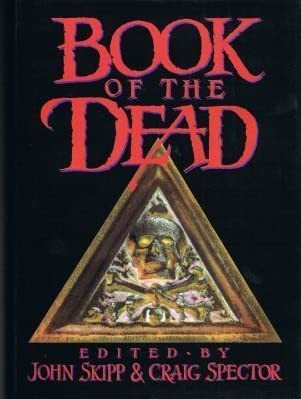 On the fiction front the 1970s and 80s, despite being in the midst of a still-unsurpassed horror boom, were relatively quiet zombie-wise. Sure, there were some isolated examples—Joe Lansdale’s DEAD IN THE WEST (the first of Lansdale’s “Weird western” novels and a fast, fun read), Candace Caponegro’s THE BREEZE HORROR (an early example of extreme horror fiction), Jack Ketchum’s SHE WAKES—but it wasn’t until the publication of the John Skipp and Craig Spector edited anthology BOOK OF THE DEAD in 1989, and its 1992 sequel STILL DEAD, that writers really caught the zombie bug.
On the fiction front the 1970s and 80s, despite being in the midst of a still-unsurpassed horror boom, were relatively quiet zombie-wise. Sure, there were some isolated examples—Joe Lansdale’s DEAD IN THE WEST (the first of Lansdale’s “Weird western” novels and a fast, fun read), Candace Caponegro’s THE BREEZE HORROR (an early example of extreme horror fiction), Jack Ketchum’s SHE WAKES—but it wasn’t until the publication of the John Skipp and Craig Spector edited anthology BOOK OF THE DEAD in 1989, and its 1992 sequel STILL DEAD, that writers really caught the zombie bug.
BOOK OF THE DEAD was conceived as essentially the literary equivalent of THE DEAD NEXT DOOR: a direct tribute to George Romero, who penned an admiring forward. The book contains a myriad of zombie fiction ranging from the epic (Steven R. Boyett’s “Like Pavlov’s Dogs,” Joe Lansdale’s “On the Far Side of the Cadillac Desert with Dead Folks”) to the goofy (Ramsey Campbell’s “It Helps if You Sing”), but there’s one tale that really struck a chord.
That would be Philip Nutman’s “Wet Work,” a short and stark account that detailed the outrageous carnage wreaked on the living dead by zombie-killing hitmen. The story admittedly hasn’t dated well (these days it comes off as essentially a miniature RESIDENT EVIL) but back in 1989 there was nothing else quite like it. Nutman expanded the story to novel-length in 1994, but the results were underwhelming.
By the advent of the 1990s it seemed the zombie floodgates were open in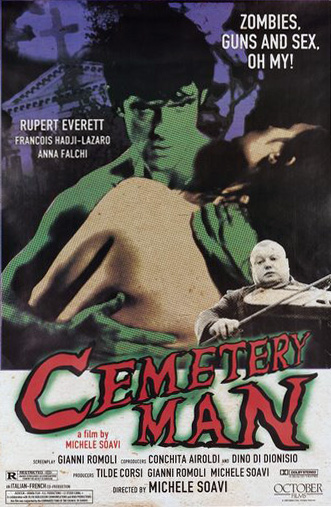 fiction, and certainly film. Zombie cinema arguably reached its apotheosis in the nineties, which began with a passable Tom Savini directed remake of NIGHT OF THE LIVING DEAD. The decade’s succeeding entries ranged from the comedic (BRAINDEAD/DEAD-ALIVE), the arty (SHATTER DEAD), the futuristic (LAUGHING DEAD—not to be confused with THE LAUGHING DEAD), the surreal (DELLAMORTE DELLAMORE/CEMETERY MAN) and the vampiric (Leif Jonker’s DARKNESS, which harkened back to I AM LEGEND with its vampires that act like zombies). The Japanese even got into the act with 1998’s BIO-ZOMBIE/SUN FAA SAU SI, an early example of the “J-Horror” cycle that would predominate in the 00’s.
fiction, and certainly film. Zombie cinema arguably reached its apotheosis in the nineties, which began with a passable Tom Savini directed remake of NIGHT OF THE LIVING DEAD. The decade’s succeeding entries ranged from the comedic (BRAINDEAD/DEAD-ALIVE), the arty (SHATTER DEAD), the futuristic (LAUGHING DEAD—not to be confused with THE LAUGHING DEAD), the surreal (DELLAMORTE DELLAMORE/CEMETERY MAN) and the vampiric (Leif Jonker’s DARKNESS, which harkened back to I AM LEGEND with its vampires that act like zombies). The Japanese even got into the act with 1998’s BIO-ZOMBIE/SUN FAA SAU SI, an early example of the “J-Horror” cycle that would predominate in the 00’s.
The irony is that few people saw any of the above films, impressive though most of them were. This probably explains why the following decade’s zombie media explosion didn’t seem as anticlimactic to most of the public as it did to me.
Before leaving the 1990s I’ll have to mention the zombie-themed video games. ALONE IN THE DARK premiered in 1992 and the massively influential first-person shooter game DOOM debuted the following year, followed by RESIDENT EVIL, DIABLO, THE HOUSE OF THE DEAD and SILENT HILL. Nearly all of those games were adapted for film in the following decade, in which zombie fever overtook popular culture like…well, a swarm of zombies.
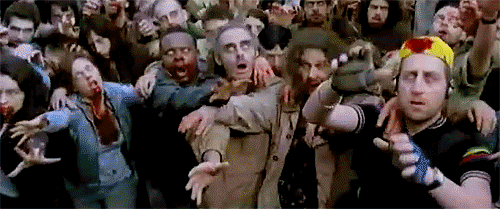 To conclusively document every zombie-themed film/book/game released in the past decade would probably take forever (over half of the 994 “Zombie” titles listed on the IMDB are from the last ten years). Every year, it seems, brought several forgettable zombie flicks misleadingly touted as the next NIGHT OF THE LIVING DEAD/EVIL DEAD/RE-ANIMATOR: JUNK, THE DEAD HATE THE LIVING, STACY, VERSUS, CHILDREN OF THE LIVING DEAD, UNDEAD, DEAD AND BREAKFAST, FEEDING THE MASSES, AUTOMATON TRANSFUSION, etc, etc, etc. Hollywood being as it is these days, we also got remakes of some previously mentioned titles, with a NIGHT OF THE LIVING DEAD 3-D and new DAWN and DAY OF THE DEADS (of which only the ‘04 DAWN has any real worth), along with an updated (not for the better!) adaptation of I AM LEGEND.
To conclusively document every zombie-themed film/book/game released in the past decade would probably take forever (over half of the 994 “Zombie” titles listed on the IMDB are from the last ten years). Every year, it seems, brought several forgettable zombie flicks misleadingly touted as the next NIGHT OF THE LIVING DEAD/EVIL DEAD/RE-ANIMATOR: JUNK, THE DEAD HATE THE LIVING, STACY, VERSUS, CHILDREN OF THE LIVING DEAD, UNDEAD, DEAD AND BREAKFAST, FEEDING THE MASSES, AUTOMATON TRANSFUSION, etc, etc, etc. Hollywood being as it is these days, we also got remakes of some previously mentioned titles, with a NIGHT OF THE LIVING DEAD 3-D and new DAWN and DAY OF THE DEADS (of which only the ‘04 DAWN has any real worth), along with an updated (not for the better!) adaptation of I AM LEGEND.
Some interesting films emerged from this morass, including the international smash SHAUN OF THE DEAD, a zombie comedy that was genuinely funny and a really good movie to boot; the French THEY CAME BACK/LES REVANANTS, a compellingly low key affair with a new type of ghoul: the sleeper cell zombie that bides its time then attacks without warning; the stylish and inspired THE ROOST, which neatly transcended its clichéd narrative; FIDO, which wittily fleshed out the concept of zombies as manual labor; AMERICAN ZOMBIE, a genuinely clever account of a Burning Man-type festival for ghouls; and 28 WEEKS LATER, which outdid its predecessor, the solid but wildly overrated 28 DAYS LATER, in shock and intensity.
Zombies have heated up on the literary front as well. Brian Keene’s Romero-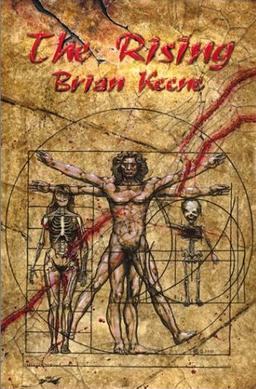 inspired debut novel THE RISING is generally credited with kicking off the literary zombie boom in 2003. Actually, Keene’s novel will have to share credit with the same year’s ZOMBIE SURVIVAL GUIDE by Max Brooks (Mel’s son), a clever and affectionate take on zombie mythos that became a veritable mini-phenomenon. Keene followed THE RISING with the similarly themed CITY OF THE DEAD and DEAD SEA, while Brooks gave us 2007’s WORLD WAR Z: AN ORAL HISTORY OF THE ZOMBIE WAR, an enormously imaginative account of an epic human-zombie conflict that together with its predecessor spawned a cottage industry of how-to zombie guides and/or mock oral histories: ZOMBIES: A RECORD OF THE YEAR OF INFECTION, ZOMBIES FOR ZOMBIES, THE ZOMBIE SURVIVAL GUIDE: HOW TO LIVE LIKE A KING AFTER THE OUTBREAK, and so on.
inspired debut novel THE RISING is generally credited with kicking off the literary zombie boom in 2003. Actually, Keene’s novel will have to share credit with the same year’s ZOMBIE SURVIVAL GUIDE by Max Brooks (Mel’s son), a clever and affectionate take on zombie mythos that became a veritable mini-phenomenon. Keene followed THE RISING with the similarly themed CITY OF THE DEAD and DEAD SEA, while Brooks gave us 2007’s WORLD WAR Z: AN ORAL HISTORY OF THE ZOMBIE WAR, an enormously imaginative account of an epic human-zombie conflict that together with its predecessor spawned a cottage industry of how-to zombie guides and/or mock oral histories: ZOMBIES: A RECORD OF THE YEAR OF INFECTION, ZOMBIES FOR ZOMBIES, THE ZOMBIE SURVIVAL GUIDE: HOW TO LIVE LIKE A KING AFTER THE OUTBREAK, and so on.
A fairly recent inductee into the world of zombie lit is J.L. Bourne, an active duty military officer who penned the enormously popular DAY BY DAY ARMAGEDDON in 2009 and a sequel in ‘10. There’s also college professor Kim Paffenroth, who’s gained a fair amount of popularity for his zombie novels (including DYING TO LIVE: LIFE SENTENCE and THE WORLD IS DEAD) put out by the above-mentioned Permuted Press, which also publishes such zombie-friendly authors as Z.A. Recht (PLAGUE OF THE DEAD: THE MORNINGSTAR STRAIN) and Tony Monchinski (EDEN), and anthologies like THE UNDEAD and the Paffenroth edited HISTORY IS DEAD. Other notable anthologies include the John Skipp edited ZOMBIES: ENCOUNTERS WITH THE HUNGRY DEAD, the two-volume THE LIVING DEAD and Christopher Golden’s THE NEW DEAD. Stephen King even got into the act in 2006 with THE CELL, a pretty standard zombie mash intended as a(nother) tribute to the films of George Romero.
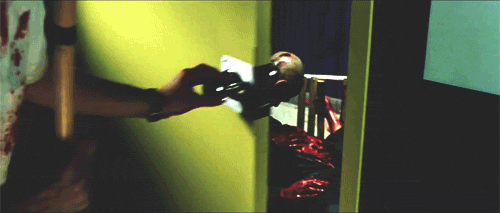 Speaking of whom: Mr. Romero, the father of the modern zombie tale, remained active in zombie cinema until his 2017 demise. His first three zombie-themed efforts were supposed to comprise a standalone trilogy, yet after a succession of stalled projects Romero grudgingly returned to the genre that made him famous with LAND OF THE DEAD (2005), DIARY OF THE DEAD (2007) and SURVIVAL OF THE DEAD (2009). I enjoyed all three films but could sense that Romero was clearly growing bored with the living dead (especially evident in SURVIVAL, wherein the zombies are relegated to background action)—as, for that matter, are quite a few of us!
Speaking of whom: Mr. Romero, the father of the modern zombie tale, remained active in zombie cinema until his 2017 demise. His first three zombie-themed efforts were supposed to comprise a standalone trilogy, yet after a succession of stalled projects Romero grudgingly returned to the genre that made him famous with LAND OF THE DEAD (2005), DIARY OF THE DEAD (2007) and SURVIVAL OF THE DEAD (2009). I enjoyed all three films but could sense that Romero was clearly growing bored with the living dead (especially evident in SURVIVAL, wherein the zombies are relegated to background action)—as, for that matter, are quite a few of us!
Finally…
Please understand, I have enormous affection and respect for zombie media, which should be evident in the foregoing overview, and fully acknowledge the many worthwhile novels, stories and movies on the subject. At some point, though, we all have to move forward, and I’d argue that, in the wake of NIGHT OF THE LIVING DEAD and the ensuing four decades of apocalyptic mayhem, zombies are now officially things of the past.
